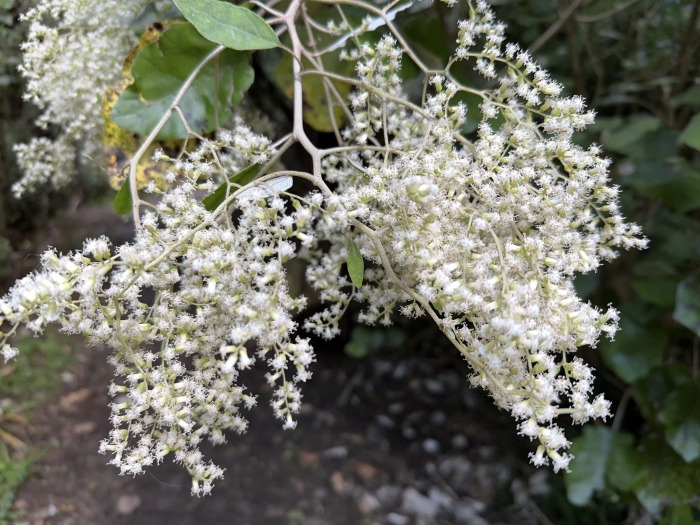Rangiora
(Brachyglottis repanda)
Rangiora (Brachyglottis repanda)
/
/

Tom Beard
CC BY 4.0
Image By:
Tom Beard
Recorded By:
Copyright:
CC BY 4.0
Copyright Notice:
Photo by: Tom Beard | License Type: CC BY 4.0 | License URL: http://creativecommons.org/licenses/by/4.0/ | Rights Holder: Tom Beard | Publisher: iNaturalist | Date Created: 2023-10-11T04:22:41Z |























Estimated Native Range
Summary
Brachyglottis repanda, commonly known as rangiora or bushman’s friend, is a semi-evergreen shrub native to the coastal and lowland forests of New Zealand. It can grow as a small tree or tall shrub, typically reaching up to 23 feet in height. Rangiora has distinctive large, leathery leaves with a soft, furry underside, which gives it its common name as the leaves were used by bushmen for toilet paper. The plant produces clusters of yellow florets arranged in panicle inflorescences, which bloom from August to October and are attractive to local pollinators.
Rangiora is valued for its ease of cultivation from seed or cuttings and its low maintenance requirements. It prefers well-drained soils, moderate watering, and can tolerate a range of light conditions from full sun to part shade. In gardens, it is often used for its lush foliage and as a privacy screen or hedge. The plant has historical significance, as it was traditionally used by Māori for medicinal purposes, including wound healing, and the large leaves were also used as a food wrap. While rangiora is generally disease-resistant, it can be prone to root rot in overly wet conditions.CC BY-SA 4.0
Rangiora is valued for its ease of cultivation from seed or cuttings and its low maintenance requirements. It prefers well-drained soils, moderate watering, and can tolerate a range of light conditions from full sun to part shade. In gardens, it is often used for its lush foliage and as a privacy screen or hedge. The plant has historical significance, as it was traditionally used by Māori for medicinal purposes, including wound healing, and the large leaves were also used as a food wrap. While rangiora is generally disease-resistant, it can be prone to root rot in overly wet conditions.CC BY-SA 4.0
Plant Description
- Plant Type: Shrub
- Height: 6-10 feet
- Width: 6-10 feet
- Growth Rate: Moderate
- Flower Color: Yellow
- Flowering Season: Spring, Summer
- Leaf Retention: Evergreen
Growth Requirements
- Sun: Full Sun, Part Shade
- Water: Medium
- Drainage: Medium, Fast
Common Uses
Bird Garden, Border Plant, Low Maintenance, Potted Plant, Street Planting
Natural Habitat
Coastal and lowland forests of New Zealand
Other Names
Common Names: Rangiora, Leatherwood, Pukapuka, Bushman’s Friend
Scientific Names: , Brachyglottis repanda, Brachyglottis forsteri, Brachyglottis rangiora, Brachyglottis rangiora, Brachyglottis rangiora subsp. atropurpurea, Brachyglottis repanda, Brachyglottis repanda var. fragrans, Brachyglottis repanda var. rangiora, Cineraria repanda
GBIF Accepted Name: